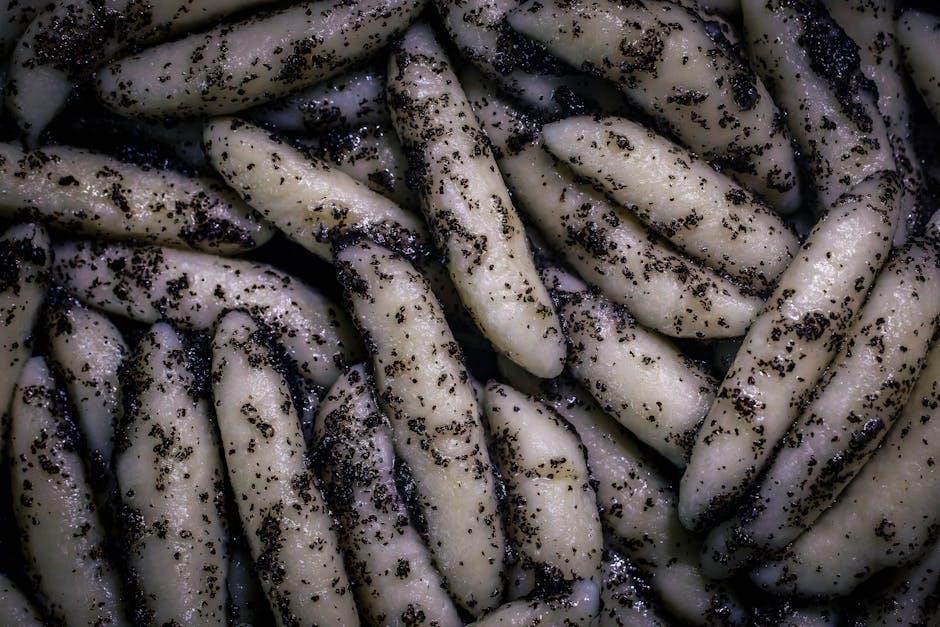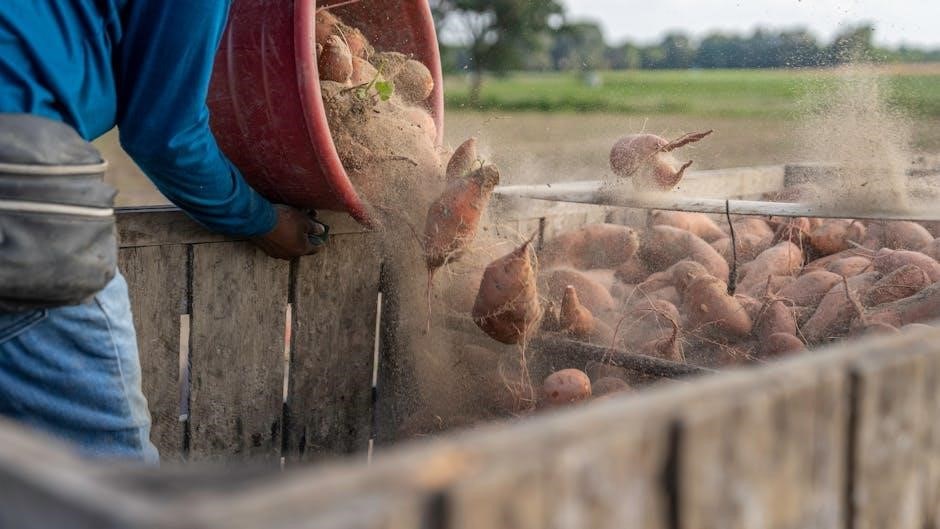Sweet potatoes are a nutrient-rich superfood, offering exceptional versatility in cooking and numerous health benefits. The Wyse Guide provides expert tips, recipes, and farming insights to maximize their potential.
Overview of Sweet Potatoes and Their Importance
Sweet potatoes are a nutrient-dense superfood, highly adaptable to various climates, making them a vital crop globally. They are rich in vitamins A and C, fiber, and antioxidants, promoting health and energy. Their versatility in both sweet and savory dishes has made them a culinary favorite. The Wyse Guide highlights their importance as a sustainable and nutritious addition to modern diets, offering practical tips for growers and cooks alike. By focusing on their benefits and uses, the guide encourages embracing sweet potatoes as a staple for better health and flavorful meals;
Kaleb Wyse’s Wyse Guide is a comprehensive resource dedicated to maximizing the potential of sweet potatoes. The guide offers expert farming techniques, nutritious recipes, and practical advice for both growers and home cooks. By sharing insights from years of farming experience, Kaleb empowers individuals to cultivate and utilize sweet potatoes effectively. The Wyse Guide also fosters a supportive community, encouraging knowledge sharing and collaboration among subscribers. This guide is designed to inspire and educate, helping everyone make the most of this versatile and nutritious crop.

History and Origin of Sweet Potatoes
Sweet potatoes originated thousands of years ago in the Americas, serving as a staple crop in ancient cultures before spreading globally through exploration and trade.

A Brief History of Sweet Potatoes
Sweet potatoes have a rich history dating back over 7,000 years to ancient civilizations in the Americas. They were a primary food source for many indigenous cultures and played a vital role in their survival. The crop was not only a staple but also held cultural and spiritual significance. Sweet potatoes were introduced to Europe by Spanish explorers in the 16th century and later spread to Africa and Asia, where they became integral to local diets. Their adaptability and nutritional value made them a cornerstone in many cuisines worldwide, shaping agricultural practices and culinary traditions across generations.
Origin and Spread Across the Globe
Sweet potatoes originated in the Americas, with evidence of cultivation dating back over 7,000 years in the Andean region. They were a staple crop for indigenous peoples and spread throughout the Americas pre-Columbian era. Following Columbus’s voyages, sweet potatoes were introduced to Europe in the 16th century and later to Africa and Asia through trade routes. Portuguese and Spanish traders played a key role in their global dissemination. By the 18th century, sweet potatoes had become a vital crop in Africa, particularly in West Africa, and were widely cultivated in Asia, where they thrived in diverse climates. Their adaptability and nutritional value facilitated their rapid adoption, shaping agricultural and culinary practices worldwide.

Planting and Growing Sweet Potatoes
Sweet potatoes thrive in warm climates, typically planted after the last frost. They require well-prepared, loose soil rich in organic matter for optimal growth and yield.

When and How to Plant Sweet Potatoes
Plant sweet potato slips in late spring to early summer, when soil temperatures reach 65°F. Choose a sunny spot with well-draining soil. Space slips 12-18 inches apart in rows 3-4 feet wide. Water gently after planting and keep moist during the first few weeks. Avoid planting too early, as cold soil can hinder growth. Kaleb Wyse recommends using Espoma Organic Raised Bed Mix and Chicken Manure for optimal soil preparation; Proper planting techniques ensure healthy root development and a bountiful harvest.

Soil Requirements and Care Tips
Sweet potatoes thrive in well-draining, loose soil with a pH between 5.5 and 6.5. Kaleb Wyse recommends enhancing soil with Espoma Organic Raised Bed Mix and Chicken Manure for optimal growth. Ensure soil is free of rocks and debris to prevent misshapen tubers. Keep the soil consistently moist but avoid waterlogging, which can lead to rot. Mulching around plants helps retain moisture and suppress weeds. Regularly inspect plants for signs of pests or disease, addressing issues promptly to maintain healthy growth. Proper soil care and attention are essential for a successful and abundant sweet potato harvest.
Harvesting Sweet Potatoes: Timing and Techniques
Sweet potatoes are typically ready to harvest around 100 days after planting, but Kaleb Wyse recommends waiting until the first frost for optimal flavor. Use a garden fork to carefully dig around the plants, loosening the soil to avoid damaging the tubers. Gently lift the sweet potatoes, taking care not to bruise them. Once harvested, allow them to cure in a warm, dry place for 7-10 days to heal minor injuries. This step ensures longer storage life. Handle them gently to prevent damage, as bruised sweet potatoes spoil quickly. Proper harvesting techniques are key to enjoying a successful and flavorful crop.
Cooking with Sweet Potatoes

Sweet potatoes are a versatile ingredient, perfect for both sweet and savory dishes. From classic casseroles to twice-baked recipes, their rich flavor enhances any meal, offering endless culinary possibilities.
Classic Sweet Potato Casserole Recipe
Kaleb Wyse’s sweet potato casserole is a Thanksgiving staple, blending tender sweet potatoes with a crunchy pecan streusel topping and a drizzle of caramel sauce. This recipe combines sweet and savory flavors, making it a crowd-pleaser. The casserole features chunks of big sweet potatoes, a nutty streusel, and a touch of caramel, creating a delightful flavor profile. Perfect for those who love traditional casseroles, it’s a winner for any gathering. Follow the Wyse Guide for a step-by-step guide to crafting this beloved dish, ensuring your holidays are filled with warmth and delicious food.
Twice Baked Sweet Potatoes: A Step-by-Step Guide
Twice baked sweet potatoes are a standout dish that elevates ordinary flavors to extraordinary heights. This recipe, shared by Kaleb Wyse, offers a healthier yet flavorful alternative to traditional twice baked potatoes. The process involves baking sweet potatoes until tender, scooping out the flesh, and mixing it with spices and herbs. The mixture is then stuffed back into the potato skins and baked again for a golden, creamy finish. This method ensures a delicious balance of textures and tastes, making it a perfect side dish for any occasion. Follow the Wyse Guide for a detailed, step-by-step approach to creating this mouthwatering recipe.
Other Delicious Sweet Potato Recipes
Beyond the classic casserole and twice-baked recipes, sweet potatoes offer endless culinary possibilities. Try a mouthwatering sweet potato casserole with a pecan streusel topping and caramel sauce for a sweet-and-savory delight. For a creamy twist, mashed sweet potatoes infused with garlic and herbs make a hearty side dish. Roasted sweet potato medleys with chickpeas, tofu, and spices add a vibrant, healthy option. Crispy sweet potato fries, baked to perfection, are a tasty snack. Experiment with sweet potato gnocchi for a creative pasta dish. These versatile recipes, showcased in the Wyse Guide, highlight how sweet potatoes can elevate any meal, from casual gatherings to festive celebrations.

Nutritional Benefits of Sweet Potatoes

Sweet potatoes are rich in vitamins A and C, fiber, and antioxidants, making them a powerful superfood that boosts immunity, improves digestion, and protects against chronic diseases.
Health Benefits of Sweet Potatoes

Sweet potatoes are a nutrient-dense superfood, rich in vitamins A and C, fiber, and antioxidants. These nutrients enhance immunity, improve digestion, and protect against chronic diseases like heart disease and diabetes. High fiber aids blood sugar levels and supports weight management. Antioxidants reduce inflammation, promoting overall well-being. Their complex carbs provide sustained energy and support healthy skin and vision. The Wyse Guide highlights their versatility in recipes, ensuring they can be easily incorporated into a balanced diet for improved health outcomes and reduced disease risk.
Nutritional Comparison with Regular Potatoes
Sweet potatoes surpass regular potatoes in nutritional value, offering higher levels of vitamins A and C, fiber, and antioxidants. They contain complex carbohydrates, which provide sustained energy, and have fewer calories. Sweet potatoes are rich in beta-carotene, essential for healthy vision and immune function, while regular potatoes lack this nutrient. Their higher fiber content supports better digestion and blood sugar control. Additionally, sweet potatoes have a lower glycemic index, making them a superior choice for weight management and diabetes-friendly diets. The Wyse Guide emphasizes these advantages, encouraging the inclusion of sweet potatoes in a balanced and nutritious diet for optimal health benefits.
Preserving Sweet Potatoes
Preserving sweet potatoes ensures year-round enjoyment. The Wyse Guide recommends proper storage, canning, and freezing methods to maintain their flavor and nutritional value effectively.
How to Store Sweet Potatoes for Longevity
To store sweet potatoes for longevity, choose a cool, dark place with good ventilation. Avoid washing before storage, as moisture can lead to rot. Use breathable containers or paper bags to maintain airflow. Check regularly for signs of spoilage and remove any affected tubers. For longer storage, cure sweet potatoes by keeping them in a warm, humid environment for 7-10 days before moving them to cooler conditions. Following these tips ensures your sweet potatoes remain fresh and nutritious throughout the year.
Canning and Freezing Sweet Potatoes
Canning and freezing are excellent ways to preserve sweet potatoes for year-round use. For canning, cook and mash or slice sweet potatoes, then pack them into sterilized jars, leaving space. Use a pressure canner to ensure safety. For freezing, cook and mash or slice sweet potatoes, then place them in airtight containers or freezer bags. Raw sweet potatoes can also be frozen, but cooking first helps retain texture and flavor; Label and date all containers for easy organization. When ready to use, thaw frozen sweet potatoes overnight in the fridge or reheat canned ones directly. Both methods preserve nutrients and convenience.
Wyse Guide Community and Resources
The Wyse Guide fosters a supportive farming community, with subscribers sharing tips and expertise. Kaleb Wyse’s hands-on experience and interactive resources empower growers to succeed together.
Subscriber Tips and Farming Community Support
The Wyse Guide community offers invaluable support through shared knowledge and hands-on assistance. Subscribers often volunteer on Kaleb’s farm, exchanging tips and gaining practical experience. This collaborative environment fosters growth and innovation, helping small-scale farmers thrive. By sharing insights and resources, the community ensures everyone succeeds together, creating a network of expertise and encouragement.
Kaleb Wyse’s Expertise and Farming Experience
Kaleb Wyse brings years of hands-on farming experience to the table, specializing in cultivating sweet potatoes and other crops. His expertise spans soil preparation, optimal planting techniques, and harvesting methods. By sharing his knowledge through the Wyse Guide, Kaleb empowers gardeners and farmers to achieve bountiful harvests. His practical advice and innovative strategies are rooted in real-world experience, making him a trusted resource for those seeking to grow and cook with sweet potatoes successfully.
Sweet potatoes are a versatile and nutritious staple, and the Wyse Guide offers a comprehensive approach to farming, cooking, and enjoying them. Kaleb Wyse’s expertise ensures success for growers and home cooks alike, making sweet potatoes a delightful and rewarding addition to any meal. Embrace the Wyse Guide and transform your garden and kitchen with these incredible tubers!
Final Thoughts on Sweet Potatoes
Sweet potatoes are a true culinary gem, offering unparalleled versatility and nutritional value. Whether baked, mashed, or roasted, they elevate any dish with their natural sweetness and vibrant color. The Wyse Guide has provided invaluable insights into farming, cooking, and enjoying these superfoods, making them accessible to everyone. Kaleb Wyse’s expertise ensures that growers and home cooks alike can maximize their yield and flavor. From classic casseroles to innovative recipes, sweet potatoes are a timeless delight. Embrace the Wyse Guide and unlock the full potential of this incredible ingredient, transforming your meals and garden into a thriving, flavorful experience.
Encouragement to Try the Wyse Guide
Embark on a culinary and farming journey with the Wyse Guide, your ultimate resource for mastering sweet potatoes. Packed with expert tips, mouthwatering recipes, and practical farming advice, this guide ensures success for both home cooks and growers. Kaleb Wyse’s extensive experience offers a comprehensive approach to cultivating and cooking sweet potatoes, making it easier than ever to enjoy their delicious flavor and nutritional benefits. Whether you’re a seasoned gardener or a kitchen novice, the Wyse Guide empowers you to unlock the full potential of sweet potatoes. Join the thriving community of subscribers who have already transformed their meals and gardens with this invaluable resource.
